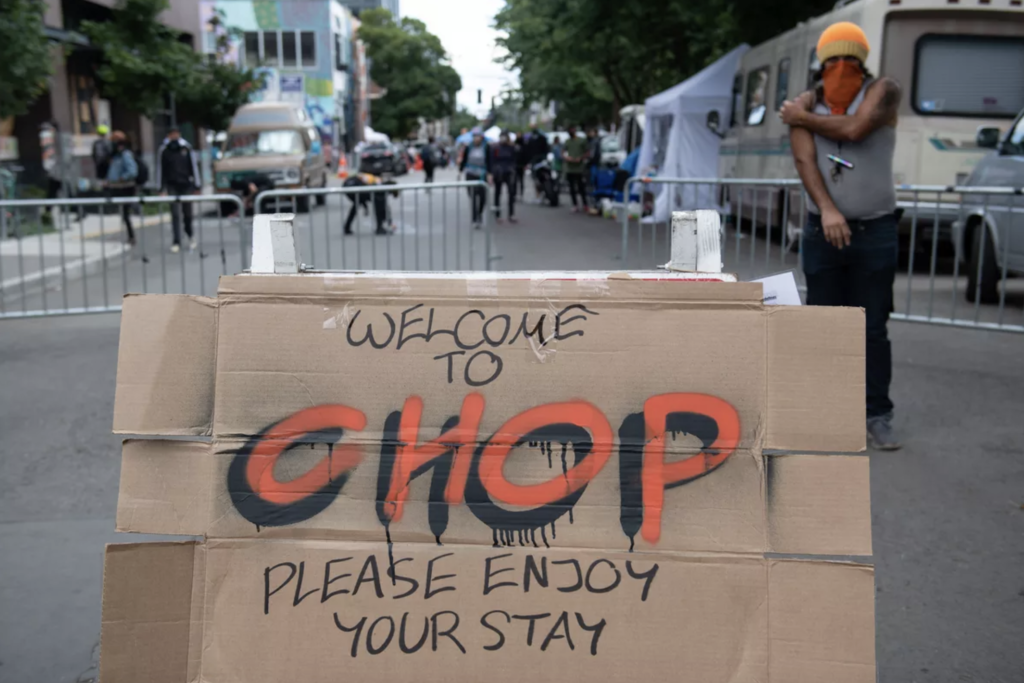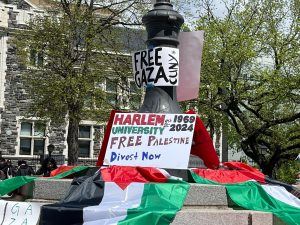One of the most common sayings about casinos is that “the house always wins.” What this means is that, even if an individual gambler is up, the casino will still collect the lion’s share of the money at the end of the day. If a successful gambler keeps playing, they will inevitably lose more and more because, at the end of the day, the house holds all the power. This analogy is helpful when thinking about the state.
Like a casino, the state holds all of the power and has set itself up in a way to ensure that it maintains that power. Across the country, the state has unleashed armies of police on the streets, arresting, beating, and kidnapping protesters without having to face any consequences. What is becoming clear to many is that the issues we’re fighting are not localized to this or that police department; they are inherent within the system of policing and — by extension — the system of capitalism itself. This system is organized on an international level and uses the full force of each national state to protect itself.
This relation of forces is important because it represents a major challenge to the current tendency that is gaining popularity as a means to resist state violence: autonomism. Autonomism first emerged as a tendency in Italy in the 1960s, in part as a reaction to the Stalinist reformism of the Italian Communist Party (PCI). Autonomism rejects the need for a party and believes that people must organize autonomously, without leaders, structures, or programs, in order to resist capitalism. As a theory, it has gained popularity in recent decades thanks to the work of thinkers like Antonio Negri and Silvia Federici.
Autonomism is a theoretical descendent of Marxism but represents a major revision of Marxist theory in a few key ways. First, it expands the definition of working class to include, among others, the unemployed and those who do unpaid reproductive labor. Second, it believes that, in the current moment, corporations have more power than the state. Lastly, autonomists reject the need for workers and oppressed people to organize together to seize the state — arguing that the Marxist strategy of overthrowing the state and establishing a worker’s government is an act of fetishzing the state.
These changes are not merely theoretical disagreements, but rather are the foundation of an entirely different strategy. While autonomists recognize that the state is an oppressive force that is beyond reform, autonomist strategy does not respond to this analysis by taking up the fight against the state through organized revolution. Rather, autonomists believe that we must resist the state by creating alternate, decentralized structures to create spaces where neither the state nor capitalism can penetrate. Through these spaces, autonomists hope to challenge the state’s hegemony and eventually expand outward. The most famous (and successful) example of an autonomist strategy in practice was the Zapatista movement in Mexico where, in the 1990s, armed militias seized areas of the country, some of which they still hold to this day. In the current moment in the United States, autonomist strategy mainly involves things like mutual aid networks, direct action, and small occupied zones — such as what has been seen this summer in Seattle and New York City.
Occupied Zones and Dual Power
For a recent example of an autonomist strategy in practice, we need only look at the City Hall Encampment (CHE) in New York City. As a participant in CHE, I helped fight back against police repression to create a “police-free zone” in Lower Manhattan. We were able to hold this space for over two weeks and use it to offer political education for the protesters and mutual aid for the unhoused. Activists would talk about how CHE was what “abolition looks like in practice,” and how the encampment demonstrated what a future world could look like. The assumption from many was that by holding the space, we were building a form of “dual power” that represented a challenge to the state. Feeding and caring for the unhoused is, of course, a worthy cause that fulfills a need the state has failed to address at every turn — but it isn’t a challenge to the state. By that same token, a space free from cops can build a sense of community — but it also doesn’t, in and of itself, create a world without police. Creating occupied zones isn’t building dual power in the true meaning of that term.
Dual power is a concept coined by Vladimir Lenin in 1917. The term described the relationship between workers’ and soldiers’ councils (the soviets) that were emerging in the revolution and the provisional government that was nominally in charge. There were, in effect, two “governments” in Russia — one of the proletariat and one of the bourgeoisie — that were in a struggle for power. This struggle was only resolved when the soviets took power and established the first workers’ government. The power of the soviets was far greater than that of any autonomous zone: they represented broad sectors of the working class, had control over production in some areas, and had their own defense forces. Dual power is not simply building power parallel to the state. Lenin did not claim that power would naturally shift from the bourgeois government to the soviets. Rather, he was very explicit about the need for the working class to organize an insurrection to overthrow the state.
The outcome of CHE shows this to be the case. As the space moved more and more into a mutual aid space, it became increasingly apolitical and hyper-localized. It was never able to form a pole of attraction for masses of workers. A similar thing occurred in Mexico, where the Zapitistas have run autonomous zones in Chiapas for decades, yet they have not been able to expand beyond their borders.
These case studies represent meaningful problems for autonomists because their strategy is to build mutual aid networks and autonomous zones into something that can expand until they can challenge and replace the state. In this hypothetical, instead of having to rely upon organs of the state for food, security, and health care, people would rely upon their own communities. This, the logic goes, will catch on locally, nationwide, and around the world. But what this strategy forgets is that the house always wins.
The State and the Working Class
The autonomist conception of the state features an important underestimation of how much power the state is willing to cede. It is possible, as the Zapatistas have shown, to defend individual autonomous zones if they are isolated, inaccessible, and relatively uninteresting to capital. But if these zones really do expand out and begin to represent a threat, the state escalates repression with the full force of the police and the military. As an example, the police in Seattle could not accept the autonomy of one neighborhood for more than a few weeks before putting it down.
The unfortunate truth is that the combined forces of the state are stronger and better organized than any decentralized network of autonomous zones can ever be. This doesn’t mean that we throw up our hands and accept that the state is eternal and resistance is futile. But if we do want to destroy the capitalist state, then we need to set about this task without any illusions.
We can neither reform the state nor work around it, so we must overthrow it. History has shown that only a revolution will remove the capitalist state. There is no getting around that fact. So, our goal shouldn’t be to elect this or that politician to “fix” the state, nor to create our own structures in hopes of carving out a “free” space within capitalism. Rather, we need to organize a fighting force capable of beating the capitalist state and taking power. Once we consider this task, the centrality of the working class is clear. If we want to defeat the capitalist state, then the greatest power that we have is in our capacity as workers because we alone have the power to stop the gears of capitalist production.
To put it another way: thousands of people occupying a city block is certainly annoying for the capitalists, and in some instances it can stop the state from performing certain functions for a short time, but all in all, it isn’t interrupting capitalism in a significant way. This is a fight on a symbolic level rather than a material one. Contrast this with a general strike, and the power of the working class couldn’t be clearer. If workers across New York City went on strike to protest against racist police violence, then the capitalists would lose billions upon billions of dollars as production ground to a halt.
This is why Marxists talk about the centrality of the working class. It is not because workers are fundamentally more advanced or revolutionary than, say, the unemployed, but because they have a much stronger strategic position. For example, the recent work stoppage in support of the Black Lives Matter movement from the dockworkers on the West Coast cost the capitalists billions — and it only lasted one day! If transit workers in New York City went on strike, it would effectively shut the city down, dealing a massive blow to the state’s ability to operate. We make everything, and we keep capitalism running. When we use our power as workers is when we start to build what is needed to win.
Localization, Parties, and Self-Organization
When the coronavirus crisis began, we saw an uptick in mutual aid organizations across the country. This happened out of necessity, as the most vulnerable people were suffering the terrible effects of both the pandemic and the resulting economic crisis. It was through mutual aid networks that many undocumented immigrants, for example, were able to keep their heads above water. Mutual aid is the way that a lot of people get drawn into activism, as it can be a powerful way to see change in your local community. However, since these networks are typically issue-specific and local, it can be hard to transition to a larger revolutionary struggle. It can be easy — and understandable — to become so focused on trying to treat the symptoms of capitalist crises that people forget to fight the disease itself.
This obstacle represents another key flaw in the autonomist strategy: it is completely localized. By rejecting the need to seize state power, autonomists make themselves unable to coordinate struggles on a macro scale. Even when they are able to establish an autonomous zone, it results in a few blocks that are (somewhat) free of capitalist oppression. That is not liberation.
We don’t want to liberate only the citizens of one community; we want to liberate the oppressed everywhere. We don’t want to feed the unhoused in one park in NYC; we want everyone to be fed — and housed as well. The hyper-focus on localization compromises that ideal. Having small pockets of liberation is not liberation, and as long as the capitalist state exists, it will actively seek to stop these pockets from expanding. Only overthrowing the state and taking the power for ourselves will ensure liberation.
The apparatus of the state is organized on a national and international level. We saw an example of this when Donald Trump threatened to unleash the U.S. military on protesters. If local police prove to be inadequate at putting down resistance, then the state will call in state troopers, the National Guard, and the military. The only way to combat that is with large-scale and widespread bodies of self-organization. In order to build these up, we need an organization of our own that can unite and coordinate struggle nationally and internationally to fight back against the state apparatus everywhere.
To fight and defeat the state, we need bodies of democratic self-organization. These bodies would help develop the struggle away from being purely defensive — which autonomous zones by their very nature are — and towards being something that could actually take power. Bodies of self-organization would allow the working class to form self-defense groups and coordinate them with workers in order to seize power. The clearest example of the power of bodies of self-organization are the soviets of the Russian Revolution. Through the soviets, workers were able to organize themselves to resist both the Tsarist state and the bourgeois democracy that came after it. From these soviets, workers were able to raise up self-defense guards that later turned into a Red Army to beat the counter-revolution. This was true dual power.
A militant organization of the working class would serve to connect local struggles to a larger strategy and help develop new activists into leaders. The sad truth is that as long as we are living under capitalism, the social issues that mutual aid networks are set up to address will never be resolved. To resolve them, we must move away from localized sects into a centralized organization of the working class that is democratically run and has a strategy for both taking up individual struggles and also connecting them to the overall movement to overthrow the capitalist state.
How We Get Free
To return to the metaphor of a casino, when thinking about the state, we must be clear that playing by their rules and hoping for a different outcome — as reformists like Bernie Sanders suggest — will result in misery. But we also can’t assume that we are taking down the casino just because we’ve found success at one poker table.. The house will always win because they’ve rigged the game. We can neither play by their rules and hope to win nor try to play by our own rules inside of their system. Instead, we must take over the casino.
So, while activists may be able to take over small niches or create strong mutual aid networks, it’s important to understand that the task before us is much bigger. These actions are small victories, which surely have their place and can have a large symbolic impact. But we don’t want to symbolically abolish the police or symbolically liberate the oppressed; we want to actually abolish the police and actually liberate the oppressed. The only way to fight the state and win is a militant organization led by the working class, fighting in our workplaces and refusing to compromise on our demands.
The fight for liberation requires both an endless imagination and a firm grasp on material reality. We cannot compromise on the world that we want to build, but we also cannot assume that we have built that world by creating one autonomous zone. We have to be more ambitious than that. We have to fight for a better world. In the words of the Irish poet and socialist James Connoly: “our demands most moderate are, we only want the Earth.” We want the Earth, and only taking power through a revolution will give it to us.











